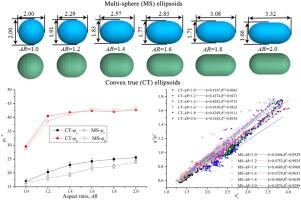Particuology ( IF 3.5 ) Pub Date : 2020-11-23 , DOI: 10.1016/j.partic.2020.11.001 Shunkai Liu , Zhihong Nie , Wei Hu , Jian Gong , Peng Lei

|
In discrete element method (DEM) simulations, multi-sphere (MS) clumped and convex particles are two main particle models that are used to study the mechanical behaviours of granular materials. Of interest is the evaluation of the effect of multiple contacts between clumped particles or single contacts between convex particles on the mechanical behaviours of granular materials. In this context, a series of drained triaxial compression tests were conducted on convex true (CT) ellipsoids and MS ellipsoids with aspect ratios (ARs) ranging from 1.0 to 2.0. The microscale results indicate that at a given AR, the critical friction angle φc changes with the particle type, whereas the peak friction angle φp is nearly independent of the particle type. The anisotropic analysis provides underlying mechanisms of the shear strength evolution from two perspectives. First, the anisotropies of granular materials are essential to shear strength as the deviatoric (q)-to-effective mean (p′) stress ratio can be expressed as the sum of the anisotropies, i.e., , where ac, an and at are the normal contact anisotropy, normal contact force anisotropy and tangential contact force anisotropy, respectively. For all samples, ac and an underpin the shear strength and are influenced by the particle type. The similar φp displayed by the CT and MS ellipsoids does not translate to similar an and ac but similar ac+an for the two particle types. In addition, owing to their larger ac+an, the CT ellipsoids have a higher φc than the MS ellipsoids. Second, there is a satisfactory linear relationship between and ac within strong and non-sliding (sn) contacts (i.e., q/p′ = ), where k is the fitting parameter. Accordingly, in the peak state, the subtle difference in shear strength is attributed to the greater in the CT ellipsoids than in the MS ellipsoids that is counteracted by the smaller k. However, in the critical state, the greater difference in between the CT and MS ellipsoids is partially offset by the smaller difference in k, causing a higher φc in the CT ellipsoids than in the MS ellipsoids.
中文翻译:

颗粒类型对粒状材料剪切行为的影响
在离散元素方法(DEM)模拟中,多球体(MS)团粒和凸粒是两个主要的颗粒模型,用于研究粒状材料的力学行为。令人感兴趣的是,对块状颗粒之间的多次接触或凸起颗粒之间的单个接触对粒状材料机械性能的影响的评估。在这种情况下,对长宽比(ARs)为1.0到2.0的凸真实(CT)椭球和MS椭球进行了一系列的排水三轴压缩测试。微尺度结果表明,在给定的AR,临界摩擦角φ Ç与颗粒类型的变化,而峰值摩擦角φ p几乎与粒子类型无关。各向异性分析从两个角度提供了抗剪强度演化的潜在机理。首先,粒状材料的各向异性是剪切强度必不可少的,因为偏差(q)与有效平均(p ')应力比可以表示为各向异性的总和,即其中一个Ç,一个Ñ和一吨是正常接触各向异性,正常接触力各向异性和切向接触力各向异性,分别。对于所有的样品,一个Ç和一个Ñ巩固剪切强度和由粒子类型的影响。类似φ p显示由CT和MS椭圆体不转化为类似一个Ñ和一个ç但相似的一个ç +一个Ñ两个颗粒类型。另外,由于它们的c +一个Ñ中,CT椭圆体具有更高的φ Ç比MS椭圆体。其次,两者之间存在令人满意的线性关系和一个ç内强和非滑动(SN)接触(即q / p '=),其中k是拟合参数。因此,在峰值状态下,剪切强度的细微差异归因于较大在CT椭圆形中比在MS椭圆形中较小的k抵消了。但是,在临界状态下, CT和MS椭球之间的距离会因 ķ,导致更高的φ Ç在CT椭圆体比在MS椭圆体。


























 京公网安备 11010802027423号
京公网安备 11010802027423号